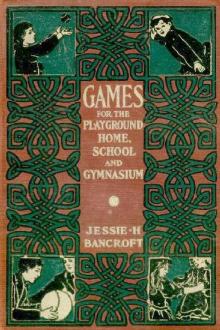Games for the Playground, Home, School and Gymnasium by Jessie Hubbell Bancroft (top novels of all time .txt) 📕

- Author: Jessie Hubbell Bancroft
- Performer: -
Book online «Games for the Playground, Home, School and Gymnasium by Jessie Hubbell Bancroft (top novels of all time .txt) 📕». Author Jessie Hubbell Bancroft
The two odd players, one of whom is runner and the other chaser, start outside of the circle, generally one of them being on one side of the circle and the other opposite. The object of the game is for the chaser to tag the runner. The runner may save himself by stopping in front of any couple standing in the circle, whereupon, that file having been made "three deep," the outer player or third man becomes at once liable to tagging, and in his turn becomes runner and tries to evade the chaser. He may seek refuge in the same way in front of a couple.
Should the chaser tag the runner, they exchange places, the runner immediately becoming chaser, and the chaser being liable instantly to tagging.
It will thus be seen that great alertness is necessary on the part of any one standing on the outside of the circle, as at any moment the runner may take refuge in front of his file or couple, making him the third man and liable to be tagged. It is not permissible for any third man to take refuge in front of the couple standing immediately on his right or left when he becomes third man.
Both runner and chaser may dash through the circle, but may not pause for a moment within the circle, except when the runner claims refuge in front of some couple. When players are inclined to confuse the play by hesitating while running through the circle, this privilege of running through is sometimes forbidden, all the chasing being confined to the outside of the circle.
VARIATION.—This game may be varied by having the players who form the circle stand face to face, with a distance of one long step between each two, instead of all facing toward the center of the circle. In this form of the game the runner takes refuge between the two forming the couple, the one toward whom his back is turned being the third man. Both runner and chaser may run between the two circles of players.
This may be made one of the jolliest games possible, and also one of the best for making slow and dull players alert and active. The author has seen many a class of slow-minded children waken to much quicker mental action as well as greater physical agility by this game. For adult players it may be thoroughly delightful. The writer recalls a class of adult business men in a Y. M. C. A. gymnasium who resorted even to leapfrog tactics in the strenuous sport they put into this game.
TOMMY TIDDLER'S GROUND5 to 30 or more players.
Playground; gymnasium.
The ground is divided by a line into two equal parts. One of these belongs to Tommy Tiddler, who stands on his side of the line and may not cross it. All of the other players are on the other side of the line, and venture across the line into Tommy Tiddler's ground, taunting him with the remark,—
Picking up gold and silver!"
Tommy may tag any one on his ground, and any one so tagged changes places with him. The players will learn to add to the interest of the game by venturing as near Tommy Tiddler as possible and being very tantalizing in inducing him to run after them. Tommy Tiddler, on his part, will find opportunity for considerable finesse, such as in appearing to give his attention entirely to one player, then suddenly turning and dashing for another.
TOSSING WANDS10 to 60 or more players.
Gymnasium; playground; schoolroom.
This game is played in two forms, line form and circle form.
LINE FORM.—The players stand in two lines or ranks facing each other, all those in one line being provided with gymnasium wands about three feet in length. A leader is appointed who either counts or commands as a signal for tossing the wands back and forth from one line to the other: as, "One, two, three—toss!" This is even more effective if gymnastic movements be taken on the three counts, as bending the trunk forward with the wand downward, stretching the arms upward with the wand overhead, extending it forward at shoulder height, and then tossing backward over the head. The signals for this would be "Bend! Stretch! Out! Toss!"
The wands should first be held in the hand with the palms upward, and caught with the hands in the same position. Later, the hand position should be reversed, the wand being grasped with the downward-turned palms.
CIRCLE FORM.—When players are proficient in catching in opposite lines or ranks, they should form a circle, facing around in single file, each player being provided with a wand which is tossed backward over the head and caught by the player behind. This may be done best rhythmically with the exercises and commands mentioned above, "Bend! Stretch! Out! Toss!" The wand should be caught with the palms outward.
Any player failing to catch a wand drops out of the game. With a little practice, however, this usually resolves itself into a quick drill rather than a game; but it is a most interesting, skillful, and diverting play.
TRADES10 to 60 or more players.
Indoors; out of doors.
This game is the boys' form of the game played by girls as "Old Woman from the Woods." The players divide into two equal parties. One party retires and decides on some trade or occupation, whereupon they advance toward the second party, saying:—
Got any work to give us to-day?"
The second party asks, "What can you do?" The first party answers, "Anything." The second party says, "Set to work, then!" whereupon they go through pantomimic motions descriptive of the occupation chosen, such as planing, sawing, or hammering, for the carpenter; the motions of the bricklayer, tailor, cobbler, motor-man, etc. The second party guesses what this pantomime indicates. Should they guess correctly, they have a turn at representing a trade. Should they fail, the first party has another trial.
When played in a playground or gymnasium, where there is a good running space, a successful guess should be followed by a chase of the actors by the guessing party, any players caught before a designated goal line is reached having to join the party of their captors. The party wins which secures all of the players.
The following activities and occupations were shown by one class of city boys: milking cows, grinding coffee, hanging wall paper, traveling salesmen (displaying and measuring goods), rooting a baseball team, Marathon race, picking cherries, basket-ball game, oiling sewing machine, blowing up bicycle tires, running a lawn mower, bricklaying.
TREE PARTY5 to 60 players.
Out of doors.
In these days of nature study this game is especially appropriate. It may be used on any ground or strip of woodland where there is a variety of trees, the game consisting in identifying the trees.
A tag or card is fastened on one or more trees of each variety within certain prescribed limits. These cards may be made as fanciful or as rustic as desired. Birch bark is very appropriate for them, and for either birch bark or a conventional card a pretty element may be added by writing some appropriate quotation or verse, after the Japanese custom. The main object of each card, however, is to bear a number. Each player is provided with a card or slip of paper containing a list of numbers corresponding to those on the trees. Thus, if fifteen trees be numbered, there should be fifteen numbers on each player's card.
The players, having been provided each with a card and pencil, wander at will over the designated territory. Whenever a number is discovered on a tree, the player, if he knows the name of the tree, writes it on his own card opposite the corresponding number. For most companies, popular rather than botanical names of the trees are permissible. At a signal—a bell, whistle, horn, or call—the players all assemble. The host or hostess then reads a correct list, each player checking the card that he holds. The player wins who has the largest number of names correct.
The writer has known this game to be a most beautiful diversion for a lawn party on a large estate, and has a feeling appreciation of how many trees most people will find it hard to name in even a familiar strip of woodland.
10 to 60 or more players.
Playground; gymnasium; parlor.
The players form a circle, with the exception of three who stand in the center. Those forming the circle and those in the center number off in threes. The players in the center take turns in calling each his number, as "One!" "Two!" or "Three!" whereupon all of the players in the circle who hold that number quickly change places with each other, the one who called the number trying to catch one as he runs to a new place. Any player so caught changes places with the caller. For instance, the center player may call "Three!" whereupon all of the Numbers Three in the circle must change places. They may do this by changing with a near neighbor, or tantalize the one who called by running across the circle.
The center players take turns in calling numbers. For instance, if the first one fails to secure a place, then the second of the center group calls. Should the first succeed in catching one of the other players, the player so caught will await his turn in the center until Numbers Two and Three have each had a turn at calling before he calls a number.
TUG OF WAR5 to 30 players.
House party; out of doors.
One player is chosen as leader, and stands up, generally with his back against a wall or post, while a second player, who is the cuckoo, bends down, as for leapfrog, with his head against the leader. The other players stand around in a circle, each placing a finger on the back of the cuckoo. The leader then "counts off" the fingers of the players with the following rhyme, indicating a finger for each accent of the rhyme:—
The wind blows under the cuckoo's nest.
Where shall this or that one go?
Shall he go east or shall he go west?
Or shall he go under the cuckoo's nest?"
The player whose finger is indicated by the last word of the rhyme must then go to any place directed by the cuckoo, who, if he has any intimation of the identity of the player, may use considerable tact in choosing a difficult or interesting place; as on some high point to which it is difficult to climb, or under some low object under which it is hard to crawl, some distant place, etc. One player, however, must be directed to hide under the cuckoo's nest, and this player takes a position at the feet of the cuckoo. This is a favored position. When all of the players have been thus disposed, the leader calls, "Pom, pom, cooketty coo!" As soon as this call is heard, the players run back and pound the





Comments (0)